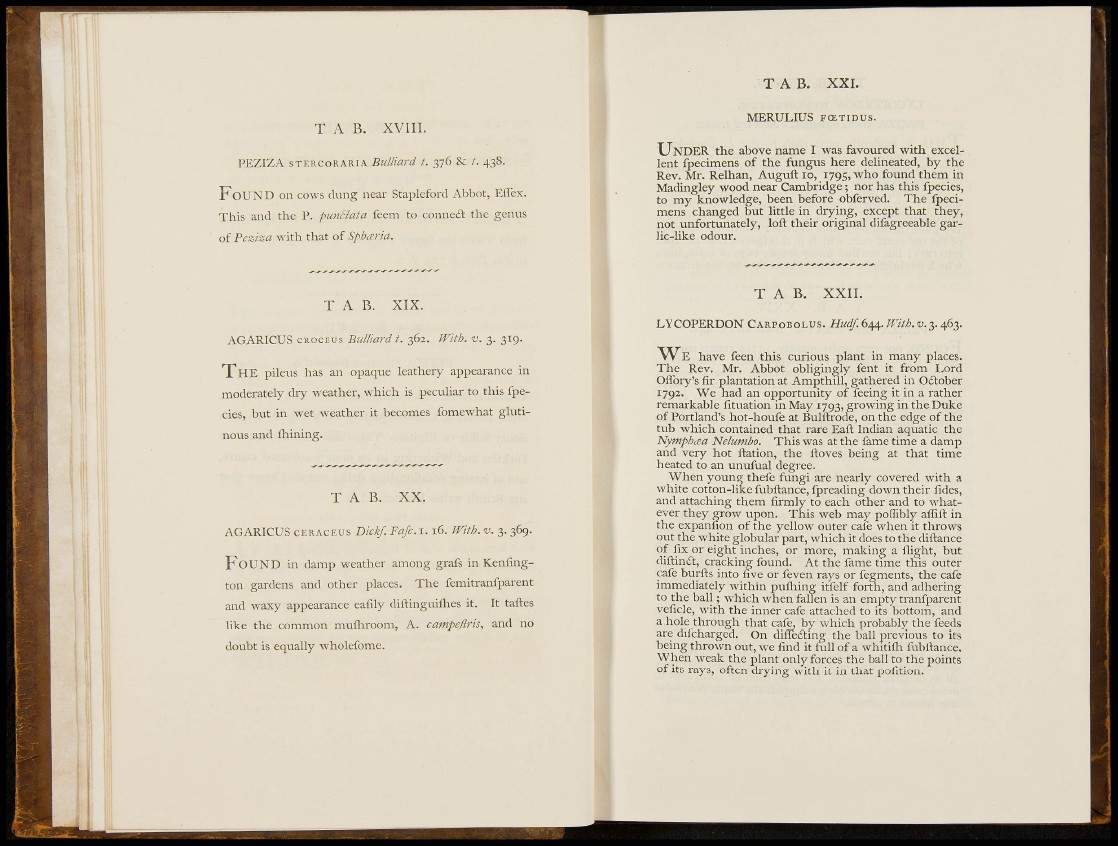
T A B . XXI.
T A B. XVIIL
PEZIZA STERCORARIA-BZ^/Z/ARRF t. 376 & t. 438.
F O U N D on cows dung near Stapleford Abbot, Eflex.
This and the P. punBata feem to conned: the genus
of Peziza with that of Spbceria.
MERULIUS FCETIDUS.
U n d e r the above name I was favoured with excellent
fpecimens of the fungus here deUneated, by the
Rev. Mr. ReUian, Auguft 10, 179S, who found them in
Madingley wood near Cambridge; nor has this fpecies,
to my knowledge, been before obferved. The fpecimens
changed but little in drying, except that they,
not unfortunately, loft their original difagreeable garlic
Uke odour.
T A B . XIX.
A G A R I C U S CROCEUS Bulliard t. 362. With. v. 3. 319.
T H E pileus has an opaque leathery appearance in
moderately dry weather, which is peculiar to this fpecies,
but in wet weather it becomes fomewhat glutinous
and lliining.
T A B . XX.
AGARICUS CERACEUS Dick/. Fafc.x. 16. With. v. 3. 369.
F O U N D in damp weather among grafs in Kenfmgton
gardens and other places. The femitranfparent
and waxy appearance eafily diftinguiihes it. It tañes
like the common muiliroom, A. campe/iris, and no
doubt is equally wholefome.
T A B . XXII.
LYCOPERDON CARPOBOLUS. Hudf.(>i^. M'ith.v.^,.
W E have feen this curious plant in many places.
The Rev. Mr. Abbot obligingly fent it from Lord
Offory's fir plantation at Ampthill, gathered in Oftober
179a. We had an opportunity of feeing it in a rather
remarkable fituation in May 1793, growing in the Duke
of Portland's hot-houfe at Bulftrode, on the edge of the
tub which contained that rare Eaft Indian aquatic the
Nymphaa Nelumbo. This was at the fame time a damp
and very hot ftation, the ftoves being at that time
heated to an unufual degree.
When young thefe fungi are nearly covered with a
white cotton-like fubftance, fpreading down their fides,
and attaching them firmly to each other and to whatever
they grow upon. This web may poifibly affift in
the expanfion of the yellow outer cafe when it throws
out the white globular part, which it does to the diftance
of fix or eight inches, or more, making a flight, but
diftindl, cracking found. At the fame time this outer
p f e burfls into five or feven rays or fegments, the cafe
immediately within pufhing itfelf forth, and adhering
to the ball; which when fallen is an empty tranfparent
veficle, with the inner cafe attached to its bottom, and
a hole through that cafe, by which probably the feeds
are difcharged. On difiTeaing the ball previous to its
being thrown out, we find it full of a whitifli fubftance.
When weak the plant only forces the ball to the points
of its rays, often drying with it in that pofition.